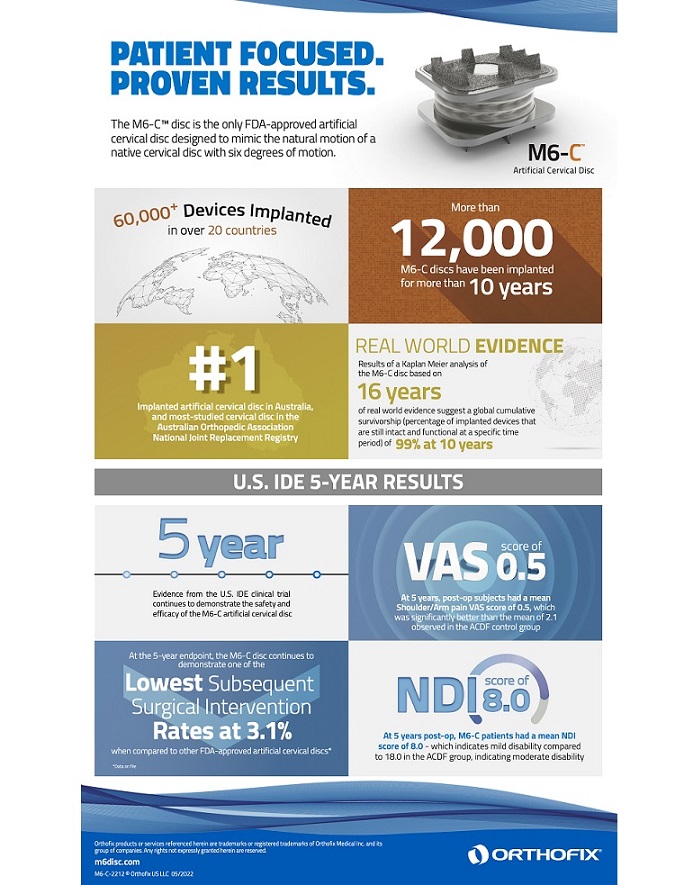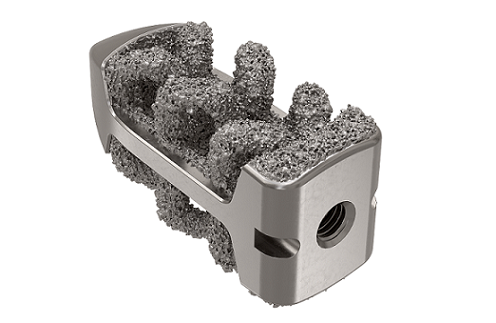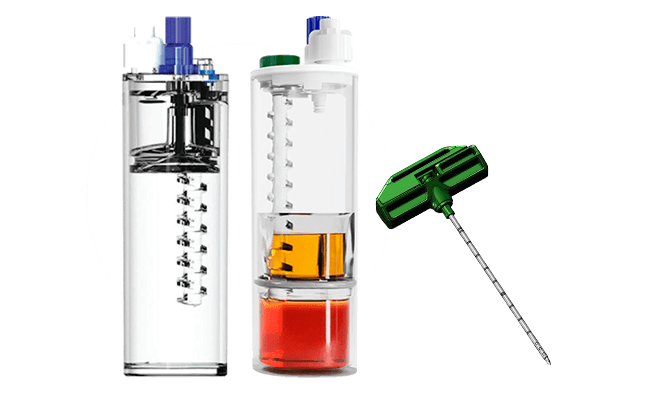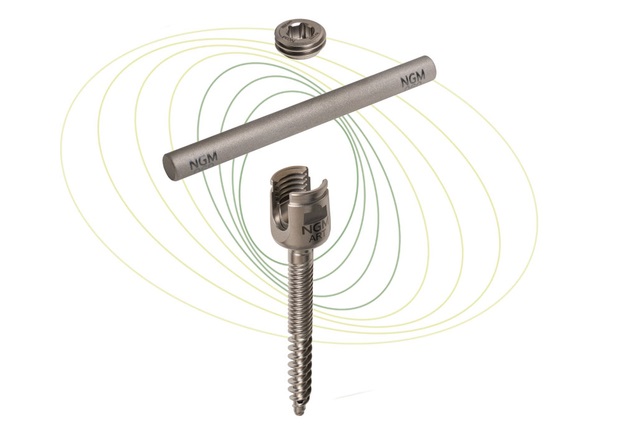
Additionally, analysis of two-year physiological range of motion data from multiple artificial cervical disc IDE studies to be presented showing benefits of the nucleus-annulus design of the M6-C disc
May 31, 2022
LEWISVILLE, Texas /OrthoSpineNews/ – Orthofix Medical Inc. (NASDAQ:OFIX), a global medical device company with a spine and orthopedics focus, today announced the presentation of five-year data from the M6-C™ artificial cervical disc single-level IDE study. These results will be presented on Friday, June 3 during the International Society for the Advancement of Spine Surgery (ISASS) annual meeting at The Atlantis Hotel in Nassau, Bahamas.
“We are pleased to see that at five years postoperative, participants in the study who received the M6-C artificial cervical disc continue to show significant benefits in Neck Disability Index (NDI) scores and neck and shoulder/arm pain Visual Analog Scale (VAS) scores compared to patients who received anterior cervical discectomy and fusion (ACDF),” said Dr. Frank Phillips, Professor of Orthopedic Surgery at Rush University Medical Center and an investigator in the study, who will present the data at the ISASS meeting. “Additionally, M6-C patients in the study had a low rate of revision surgery compared to the ACDF cohort. Patients in the study will be monitored out to 10 years post-op as we continue to compile the data supporting the efficacy and benefits of cervical disc arthroplasty with the M6-C disc.”

U.S. IDE study results at five years indicate:
- At five years, patients receiving the M6-C disc experienced a mean NDI improvement from the baseline of 47.5 points compared to 33.4 for the ACDF cohort, significantly better for the M6-C disc group.
- Statistically significant favorable results were observed in shoulder/arm pain VAS scores at five-years, with a mean of 0.5 for M6-C disc study patients and 2.1 for ACDF participants. There was a mean improvement from baseline of 6.8 for M6-C disc patients compared to 5.2 for the ACDF cohort.
- At the five-year endpoint, the M6-C artificial cervical disc continues to demonstrate one of the lowest Subsequent Surgical Interventions (SSI) rates at 3.1 percent when compared to other FDA-approved artificial cervical discs, suggesting that these rates are consistent with data reported for other FDA approved devices.
- Through five years post-op, five M6-C study patients experienced SSIs at the index level. Of the removals, two were performed due to persistent neck and arm pain (with one being replaced by a new M6-C disc,) and one was performed due to bone loss associated with a confirmed infection. In the ACDF cohort, 11 patients underwent SSIs during the five-year post-op period.
In addition to Dr. Phillips’s presentation of the five-year IDE trial data, Dr. Avinash Patwardhan, Director of the Musculoskeletal Biomechanics Laboratory at Edward Hines Jr. VA Hospital will present analysis of data regarding the likelihood of achieving physiological range of motion after cervical disc arthroplasty on Friday, June 3, during the annual meeting. This research aimed to calculate the proportion of reconstructed disc segments which yielded flexion-extension motion in the physiological range (defined as 5-16 degrees) by analyzing 24-month postoperative data reported from clinical trials of various cervical disc prostheses. On average, two-thirds of implanted segments in this cohort achieved two-year post-cervical disc arthroplasty in the 5–16-degree range, meeting the functional goals of mobility and stability after Cervical Disc Arthroplasty (CDA).
“Mobility and stability are two essential requirements which allow a spinal segment to function in harmony with its neighboring segments,” said Dr. Avinash Patwardhan. “The M6-C disc, with its inherent progressive resistance to motion provided by the nucleus-annulus design, yielded the highest proportion (103/131 or 79 percent) of implanted segments in the physiological motion range compared to the cohort average of 65 percent. These results support the functional goals of CDA which include restoring segmental range of motion and reducing the risk of accelerated adjacent segment degeneration.”
“We continue to be pleased with the U.S. IDE clinical data that now includes five-year outcomes,” said Orthofix President of Global Spine Kevin Kenny. “We recognize the importance of the ongoing collection of data from the U.S. study and implanting centers around the globe in order to expand the body of evidence that supports the clinical performance and safety of the M6-C artificial cervical disc. We look forward to continuing to disseminate and publish that data.”
About the M6-C Artificial Cervical Disc
The M6-C artificial cervical disc was commercialized outside of the United States in 2006 and has an established robust clinical history with over 60,000 discs implanted in over 20 countries, with more than 12,000 having been implanted for more than 10 years, and 25,000 implanted for more than 7 years. In addition, more than 45,000 M6-C devices were implanted prior to U.S. FDA approval.
To learn more, please visit us at booth #400 at the ISASS annual meeting.
About Orthofix
Orthofix Medical Inc. is a global medical device company with a spine and orthopedics focus. The Company’s mission is to deliver innovative, quality-driven solutions while partnering with health care professionals to improve patient mobility. Headquartered in Lewisville, Texas, Orthofix’s spine and orthopedics products are distributed in more than 60 countries via the Company’s sales representatives and distributors. For more information, please visit www.Orthofix.com.
Forward-Looking Statements
This communication contains forward-looking statements within the meaning of Section 21E of the Securities Exchange Act of 1934, as amended, and Section 27A of the Securities Act of 1933, as amended, relating to our business and financial outlook, which are based on our current beliefs, assumptions, expectations, estimates, forecasts and projections. In some cases, you can identify forward-looking statements by terminology such as “may,” “will,” “should,” “expects,” “plans,” “anticipates,” “believes,” “estimates,” “projects,” “intends,” “predicts,” “potential,” or “continue” or other comparable terminology. These forward-looking statements are not guarantees of our future performance and involve risks, uncertainties, estimates and assumptions that are difficult to predict, including the risks described in Part I, Item 1A under the heading Risk Factors in our Annual Report on Form 10-K for the year ended December 31, 2021 (the “2020 Form 10-K”). In addition to the risks described there, factors that could cause or contribute to such differences may include, but are not limited to: the risk that FDA approvals may be delayed or not be obtained; the risk that surgeons may be slow to adopt the M6-C artificial cervical disc; the risk that future patient studies or clinical experience and data may indicate that treatment with the M6-C artificial cervical disc does not improve patient outcomes as much as previously believed, or otherwise call into question the benefits of its use to patients, hospitals and surgeons; the risk that the product may not perform as intended and may therefore not achieve commercial success; the risk that competitors may develop superior products or may have a greater market position enabling more successful commercialization; the risk that insurance payers may decline to reimburse healthcare providers for the use of our products.
This list of risks, uncertainties and other factors is not complete. We discuss some of these matters more fully, as well as certain risk factors that could affect our business, financial condition, results of operations, and prospects, in reports we file from time-to-time with the SEC, which are available to read at www.sec.gov. Any or all forward-looking statements that we make may turn out to be wrong (due to inaccurate assumptions that we make or otherwise), and our actual outcomes and results may differ materially from those expressed in these forward-looking statements. You should not place undue reliance on any of these forward-looking statements. Further, any forward-looking statement speaks only as of the date hereof, unless it is specifically otherwise stated to be made as of a different date. We undertake no obligation to update, and expressly disclaim any duty to update, our forward-looking statements, whether as a result of circumstances or events that arise after the date hereof, new information, or otherwise.
Contacts
Alexa Huerta
Investor Relations
Tel 214-937-3190
alexahuerta@orthofix.com
Denise Landry
Media Relations
Tel 214-937-2529
deniselandry@orthofix.com








